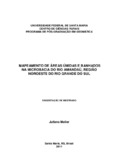| dc.creator | Meller, Juliana | |
| dc.date.accessioned | 2012-05-11 | |
| dc.date.available | 2012-05-11 | |
| dc.date.issued | 2011-04-19 | |
| dc.identifier.citation | MELLER, Juliana. Mapping of moisture soil and wetlands in the watershed of the Amandau River, northwest region of Rio Grande do Sul. 2011. 96 f. Dissertação (Mestrado em Geociências) - Universidade Federal de Santa Maria, Santa Maria, 2011. | por |
| dc.identifier.uri | http://repositorio.ufsm.br/handle/1/9549 | |
| dc.description.abstract | The wetlands are one of the world s most productive places, with high rates of
biological diversity and also highly impacted. In this context, this project was aimed at
mapping the Wetlands Ecosystems present in the soil moisture in the watershed of
the Amandau River (Watershed U30), using orbital images and clinographic terrain
maps. This research was structured in six different steps: first: choosing the area of
study; second, searching for theorical background; third, cartographic production,
using the computer program SPRING 5.1.5; forth, field research; fifth, creation of a
data bank (Access 2007), sixth, analyzes of data and consideration of the results
comparing the the Environmental Legislation. It was found that the clinographic maps
generated from the Granell-Pérez (slope from 0 to 3%) purposes became the best
available cartographic material for the identification of the humid areas and maping of
82 spots in 16 locations. The Wetland Ecosystem was identified in 62,20% of the
mapped terrains, 68,62% showing amendments from its natural characteristics
provoked by the drainage practice. It was found that 84,31% is used for raising cattle,
39,21% for damming and 15,68% for agriculture. In the biggest part of the watershed
(60,98%), the riparian vegetation of the APP (permanent preservation area) was
considered inexistent or inexpressive (3,24 meter of average). Regarding the wetland
ecosystem, 100% of the areas do not observe the use of APP according to the
Environmental Legislation (50 meters). The erosion and siltation of the hydrical
resources are in 84,15% of the areas. The basic mapping of the wetlands in moisture
soil, using the clinographic map, was fundamental to consider the first steps to the
conservation of the watershed ecosystem. Generally, it was understood that the
degradation level of the wetlands ecosystem is high and the Environmental
Legislation is not being observed. Actions to control the environmental impacts are
generated by the diverse activities in rural areas and the recovery of natural
environments, are necessary and urgent. | eng |
| dc.format | application/pdf | por |
| dc.language | por | por |
| dc.publisher | Universidade Federal de Santa Maria | por |
| dc.rights | Acesso Aberto | por |
| dc.subject | Banhados | por |
| dc.subject | Geotecnologias | por |
| dc.subject | Mapa clinográfico | por |
| dc.subject | Análise espacial | por |
| dc.subject | Wetlands | eng |
| dc.subject | Geotechnology | eng |
| dc.subject | Clinographic map | eng |
| dc.subject | Spatial analysis | eng |
| dc.title | Mapeamento de áreas úmidas e banhados na
microbacia do Rio Amandaú, região noroeste do Rio Grande do Sul | por |
| dc.title.alternative | Mapping of moisture soil and wetlands in the watershed of the Amandau River, northwest region of Rio Grande do Sul | eng |
| dc.type | Dissertação | por |
| dc.description.resumo | Os ambientes úmidos figuram entre os meios naturais mais produtivos do mundo,
com altas taxas de diversidade biológica e altamente impactados. Neste contexto, objetivouse
mapear e analisar o grau de antropismo e atendimento da Legislação Ambiental do
Ecossistema Banhado presente em áreas úmidas na Microbacia Hidrográfica do Rio
Amandaú (Bacia Hidrográfica U30), região Noroeste do Estado do Rio Grande do Sul,
utilizando-se de imagens orbitais e mapas clinográficos do terreno. A realização desta
pesquisa esteve estruturada em seis etapas: primeira: escolha da área de estudo; segunda,
fundamentação teórica; terceira, produção cartográfica, utilizando-se o SPRING 5.1.5);
quarta: trabalhos de campo; quinta: elaboração do banco de dados (Access 2007), e, sexta:
análises e discussão dos resultados em face à Legislação Ambiental. Obtiveram-se como
resultados: o mapa clinográfico (proposta de Granell-Pérez, 2001 com declividade de 0 a
3%) que constituiu-se no melhor material cartográfico para a identificação de área planas e
úmidas e o mapeamento de 82 pontos em 16 localidades. O Ecossistema Banhado foi
identificado em 62,20% e em 68,62% destes apresentaram-se alterações nas suas
características naturais provocadas pela prática da drenagem. A pecuária está presente em
82,35%, a açudagem em 39,21% e a agricultura em 15,68%. Em 60,98%, a mata ciliar da
APP é inexistente ou inexpressiva. Em relação ao Ecossistema Banhado, 100% das áreas
amostradas não atendem a Legislação Ambiental quanto à APP. A erosão e o
assoreamento dos cursos hídricos (nível moderado e acentuado) estão presentes em
84,13% das áreas. O mapeamento dos Banhados em áreas úmidas, através do mapa
clinográfico, foi de fundamental importância, podendo-se considerar o primeiro passo para a
conservação deste Ecossistema na Microbacia. De maneira geral, pode-se avaliar que o
nível de degradação do Ecossistema Banhado é alto e que a Legislação Ambiental não está
sendo cumprida. Ações de mitigação dos impactos ambientais gerados pelas atividades
diversas no meio rural e de recuperação dos ambientes naturais, faz-se necessário e são
urgentes. | por |
| dc.contributor.advisor1 | Sebem, Elódio | |
| dc.contributor.advisor1Lattes | http://lattes.cnpq.br/7879588106056349 | por |
| dc.contributor.referee1 | Cardoso, Claire Delfini Viana | |
| dc.contributor.referee1Lattes | http://lattes.cnpq.br/4489154182912581 | por |
| dc.contributor.referee2 | Meller, Cleria Bitencorte | |
| dc.contributor.referee2Lattes | http://lattes.cnpq.br/1470524437224621 | por |
| dc.creator.Lattes | http://lattes.cnpq.br/9871574741739114 | por |
| dc.publisher.country | BR | por |
| dc.publisher.department | Geociências | por |
| dc.publisher.initials | UFSM | por |
| dc.publisher.program | Programa de Pós-Graduação em Geomática | por |
| dc.subject.cnpq | CNPQ::CIENCIAS EXATAS E DA TERRA::GEOCIENCIAS | por |


